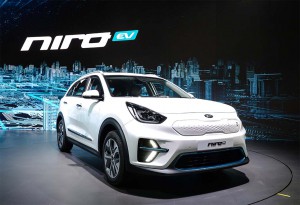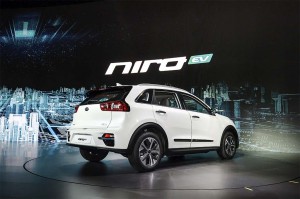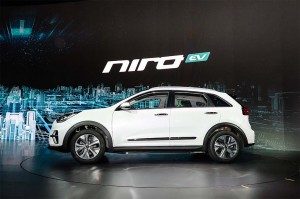Kia Motors is giving the public a look at what many in the media have already seen: the Niro EV. Introduced at the 2018 Busan auto show in South Korea, the new battery-electric Niro is a reminder that the mainstream EV market is getting more and more crowded.
The original concept was unveiled in January at the Consumer Electronics Show with the production version being shown to the media in South Korea last month, helping to round out the Niro line-up, which already has gas-powered and hybrid models.
“The Niro EV will be Kia’s second globally-sold electric vehicle, following the immensely popular Soul EV. It demonstrates the progress Kia has made in delivering comfortable, practical and fun-to-drive vehicles that lead the way in zero-emissions driving,” said Han-Woo Park, president and CEO of Kia Motors Corp.
The Niro EV has a range of about 280 miles, according to Kia, but once it goes through EPA testing, expect that to drop to about 240 miles, which is right in line with the Chevy Bolt and a bit better than the base version of Tesla Model 3.
(Production version of Kia Niro EV breaks cover. Click Here for the story.)
Kia’s newest EV offers two battery-packs: the 64-kwh battery, which puts out the aforementioned 240 miles, and a 39.2-kwh unit producing a range of just over 100 miles. Only the larger battery is expected to be offered in the U.S. However, either battery puts power to a single electric motor mounted at the front axle that delivers 201 horsepower, and a 0-62 mph time of 7.8 seconds.
The decision to offer a long-range battery stands in sharp contrast to what was done by sibling Korean brand Hyundai. Though its Ioniq model shares the same basic underpinnings as the Niro, the new Ioniq EV offers just 28 kWh of storage, enough to travel only 124 miles between charges, according to the EPA. (A longer-range version reportedly is under development but, for now, it’s the Kona that shares Niro’s 64 kWh battery.)
The Kia Niro EV features a high-tech cabin with a number of advanced driver assistance systems, including collision warning and avoidance assist, lane keeping assist which tracks vehicles in front of the car in traffic, and detects road markings to keep the Niro EV in its lane on the highway. It also controls acceleration, braking and steering depending on the surrounding vehicles at speeds up to 80 mph.
(Click Here to check out the new look for the Kia K900 luxury sedan.)
Niro EV is differentiated on the inside from other Niro models using light blue dash accents. The center console has been simplified to accommodate the car’s shift-by-wire drive selector, which features a rotary controller design. A new 7.0-inch screen in the instrument cluster allows for easy viewing of relevant information for the driver.
Designed at Kia’s design centers in California, USA and Namyang, Korea, the Niro EV incorporates the practicality and appeal of a CUV in a sleek, aerodynamic body with subtly sculptured surfaces, the company noted. The new model reveals that gaining efficiency on the road need not result in a sacrifice of compelling exterior design.
The exterior of the Niro EV is based on a ‘Clean and High-tech’ design concept. Its futuristic and aerodynamic tiger-nose grille features an integrated charging port, bearing a debossed Niro logo. Redesigned air intakes and new arrowhead-shaped LED daytime running lights combine with light blue trim highlights to make it stand out further.
(Kia bolsters line-up with launch of new Rio GT and ceed models. Click Here to check them out.)
The Niro EV will roll into Korean showrooms first, with that expected late in 2018. The automaker claims to already have 5,000 advance orders in hand for the home market with U.S. dealers getting the new model some time in early 2019. Pricing wasn’t revealed, but it’s expected to be competitive with the aforementioned Bolt, which starts at $37,495 before the $7,500 tax credit.



